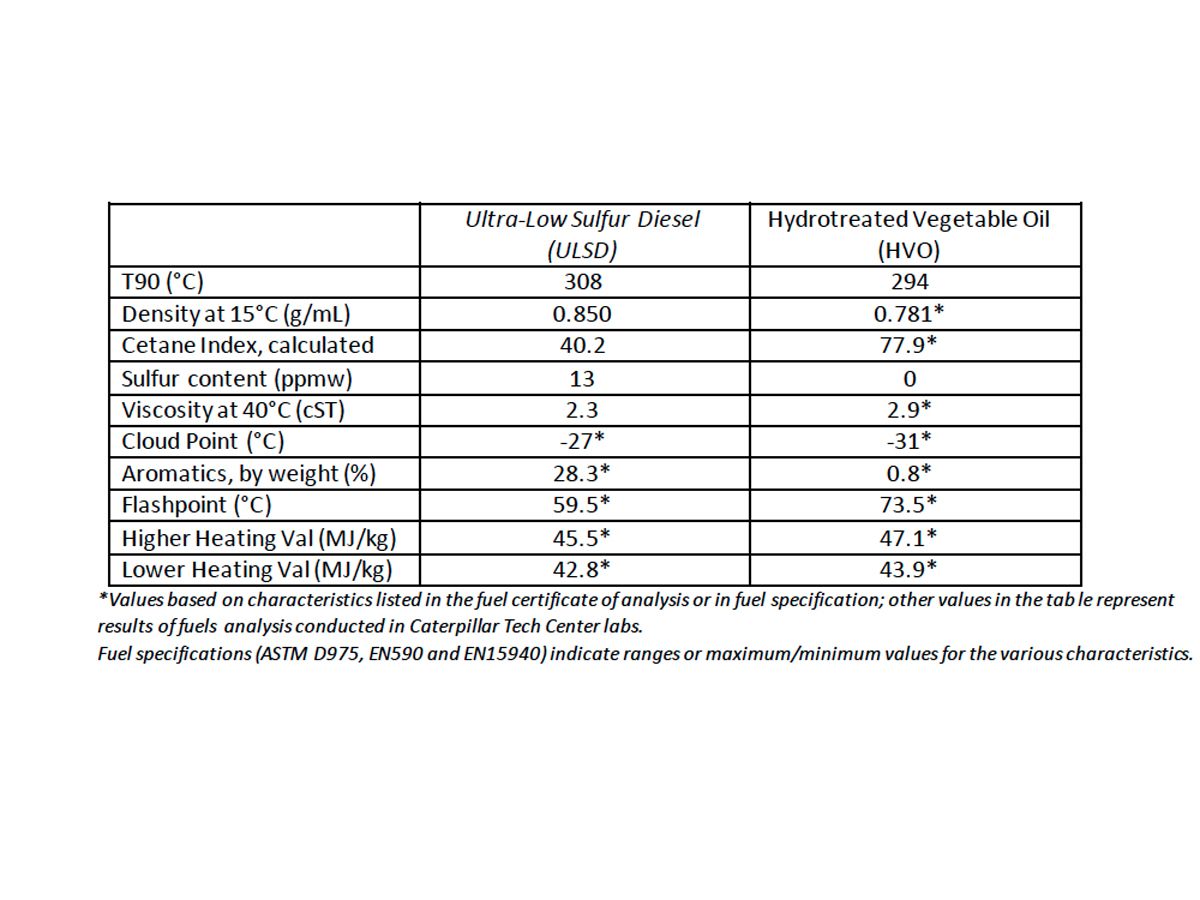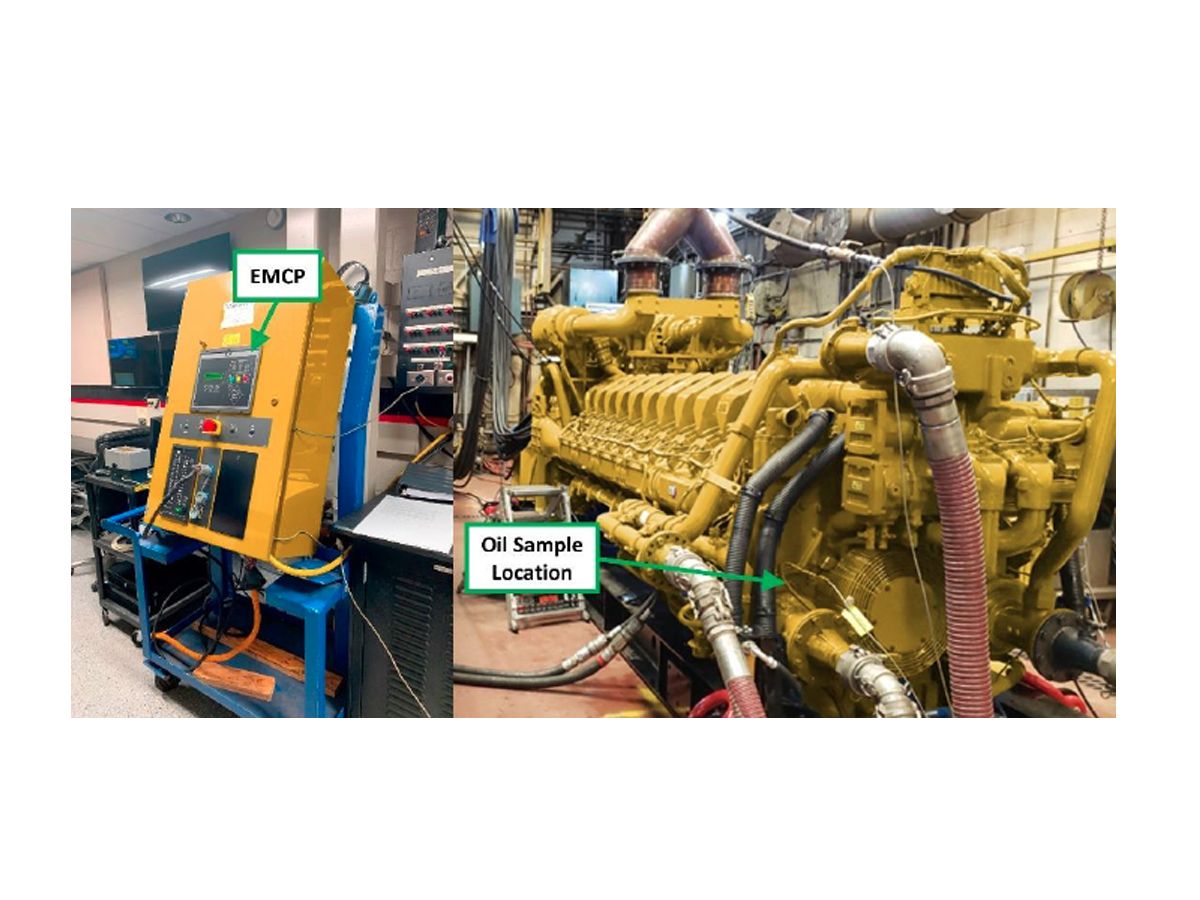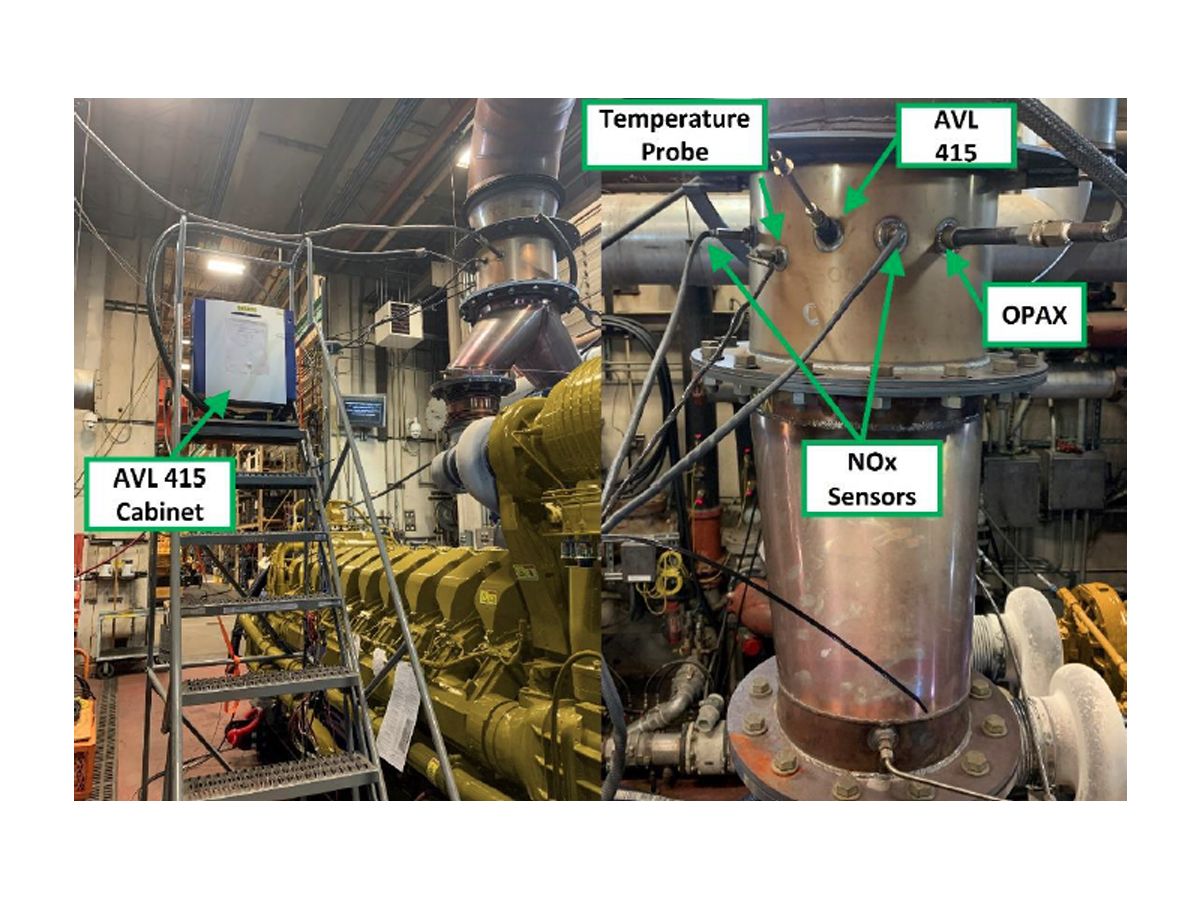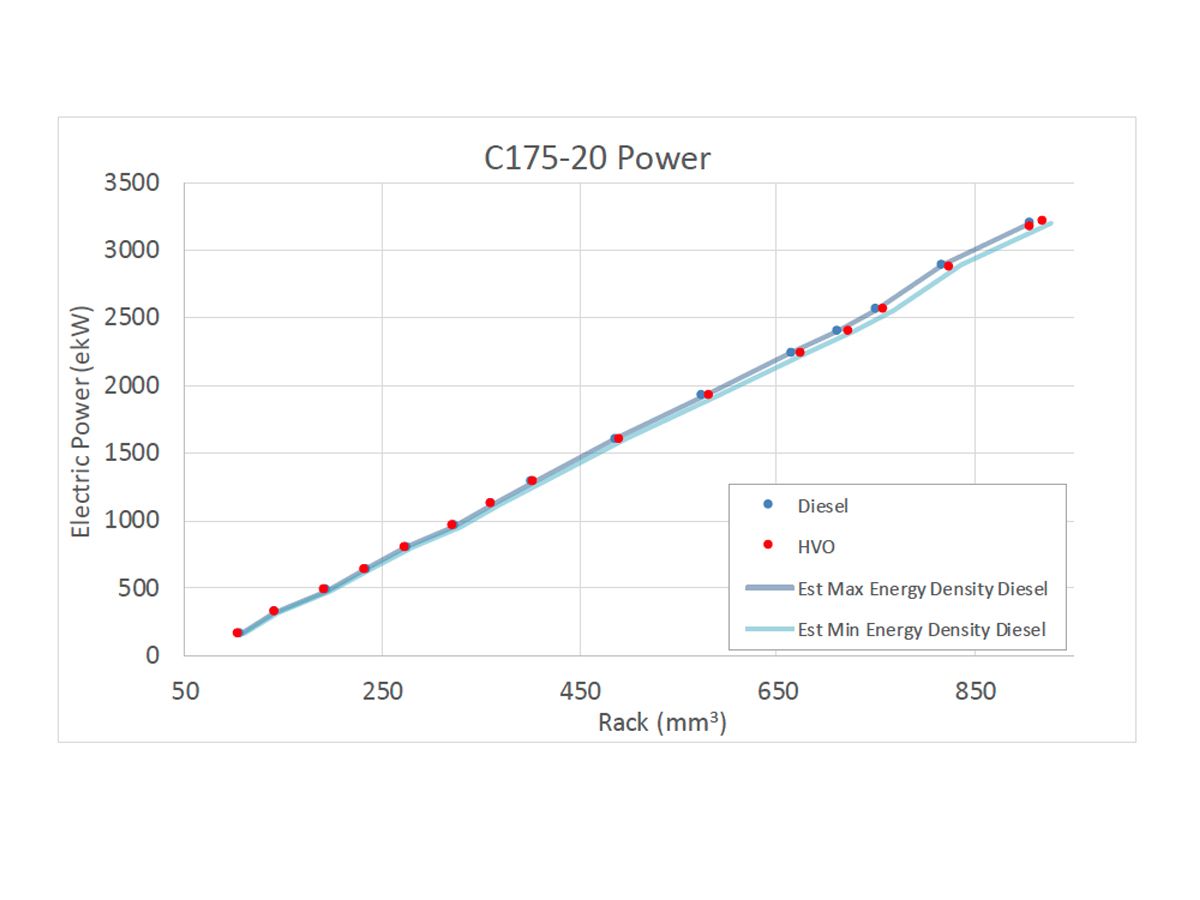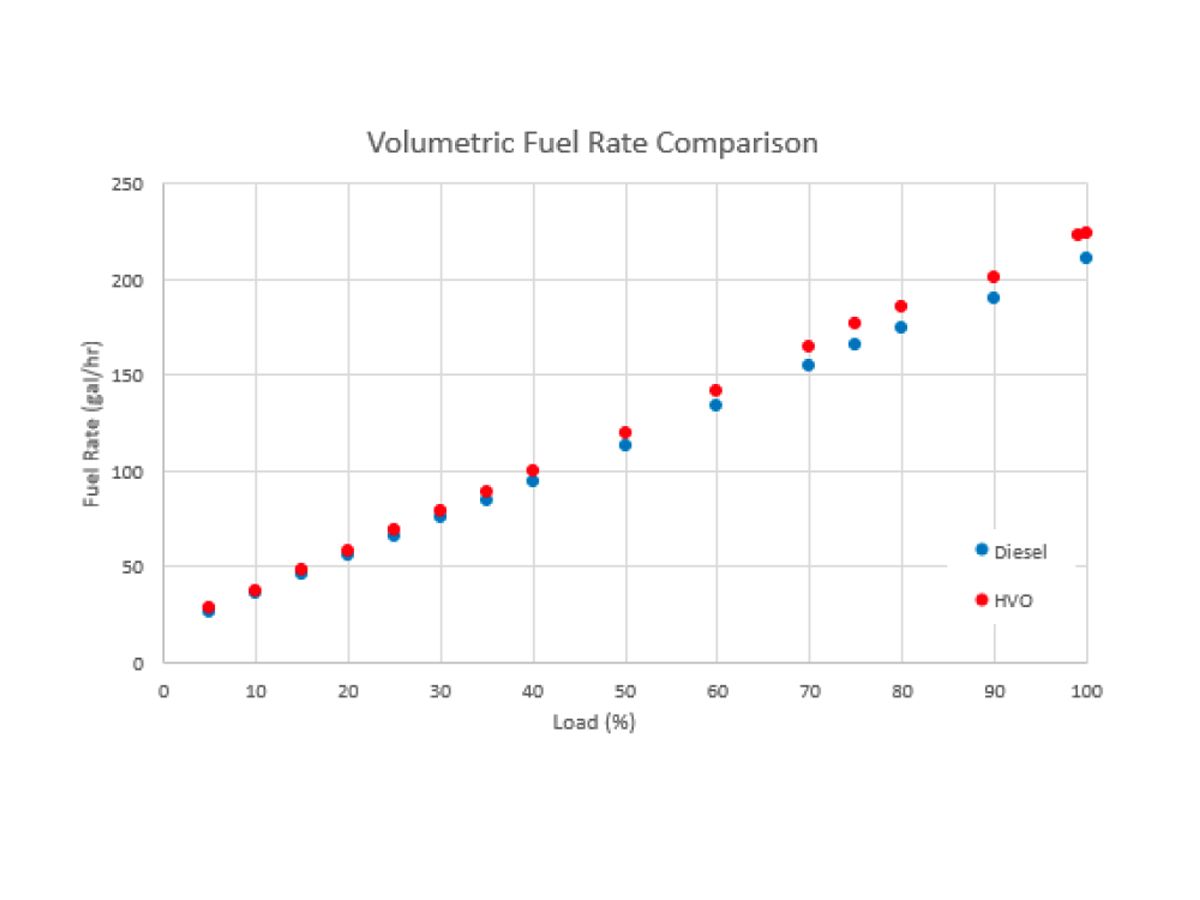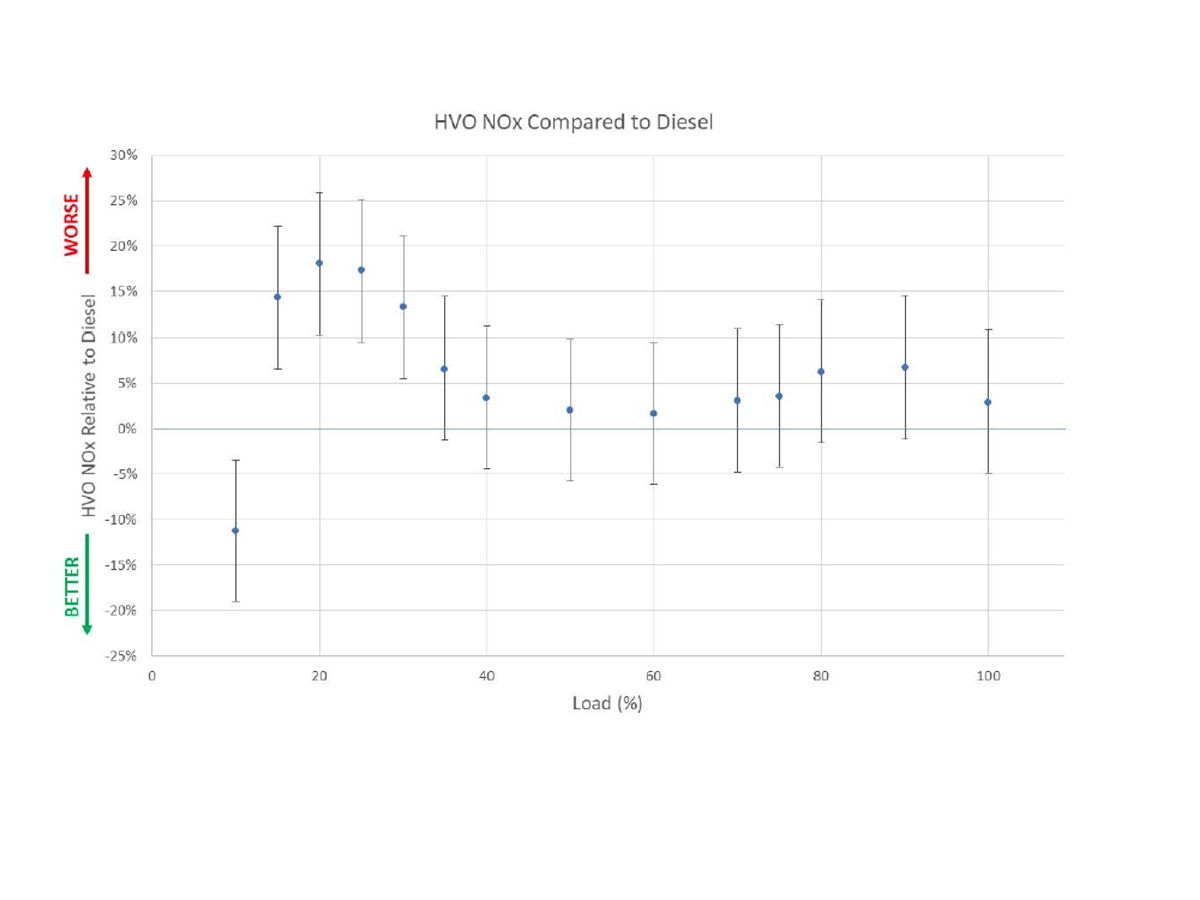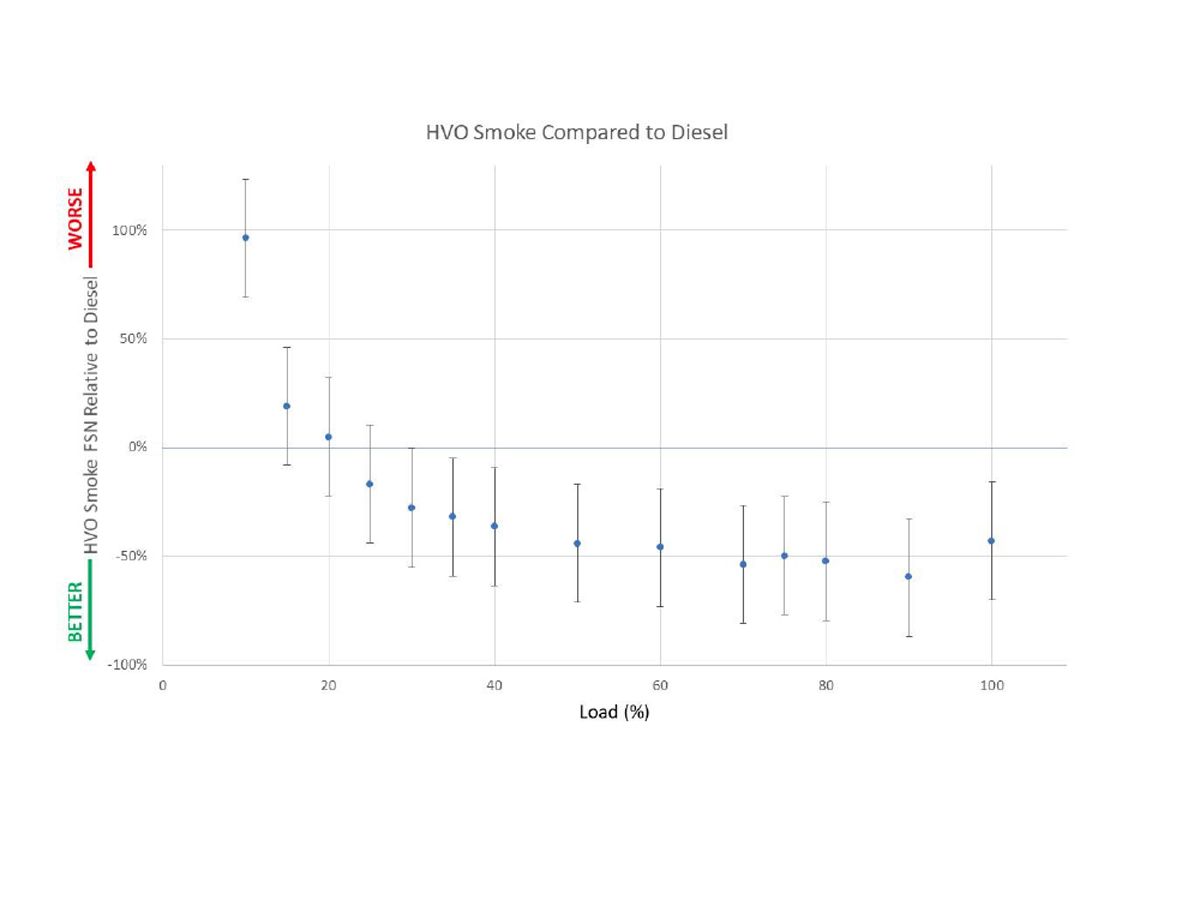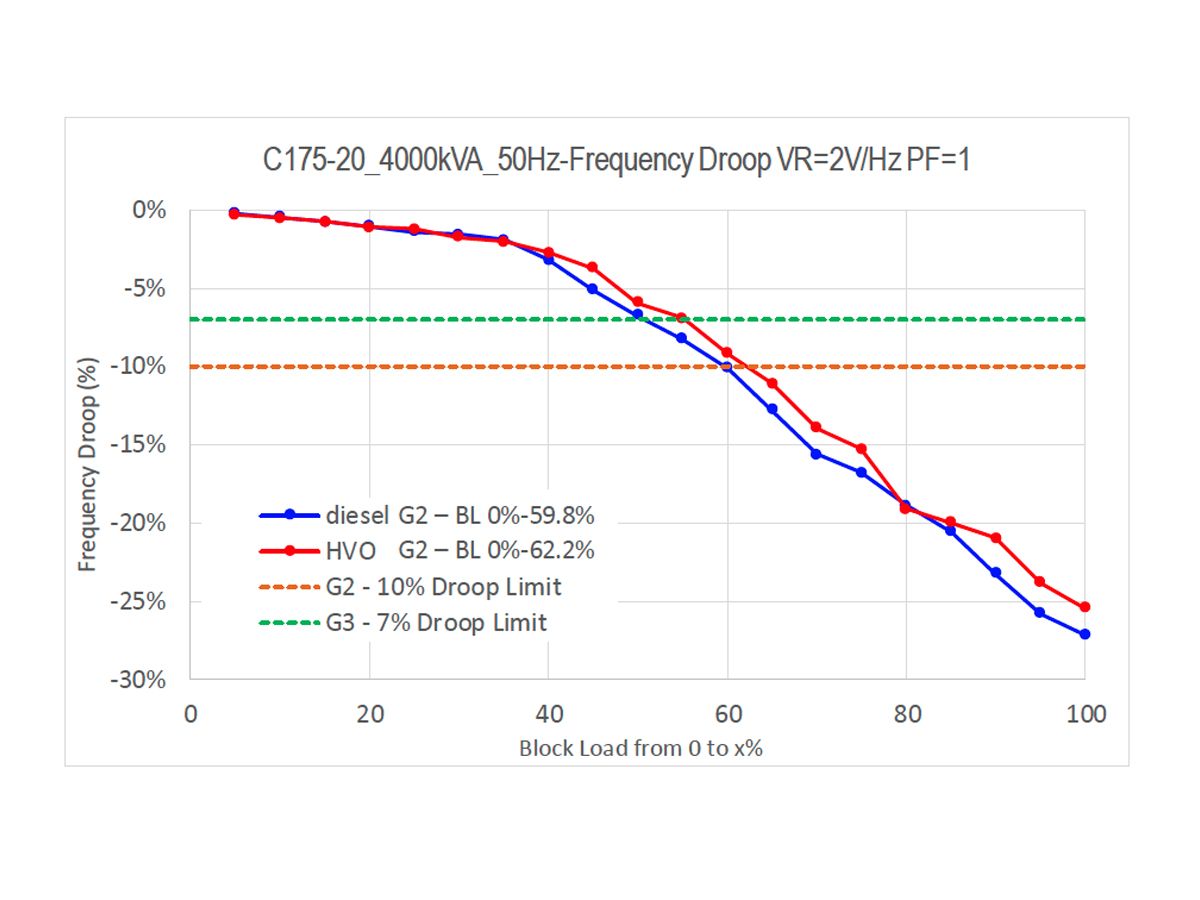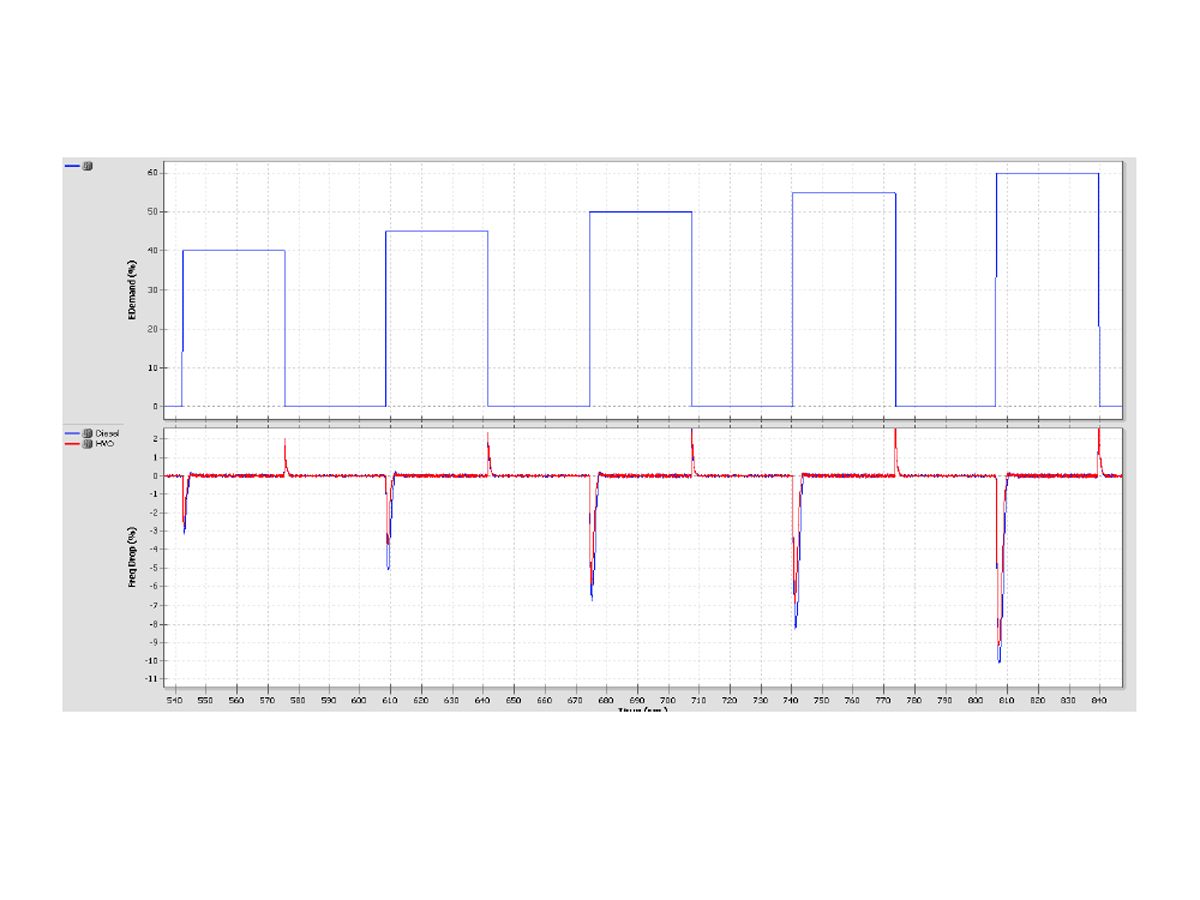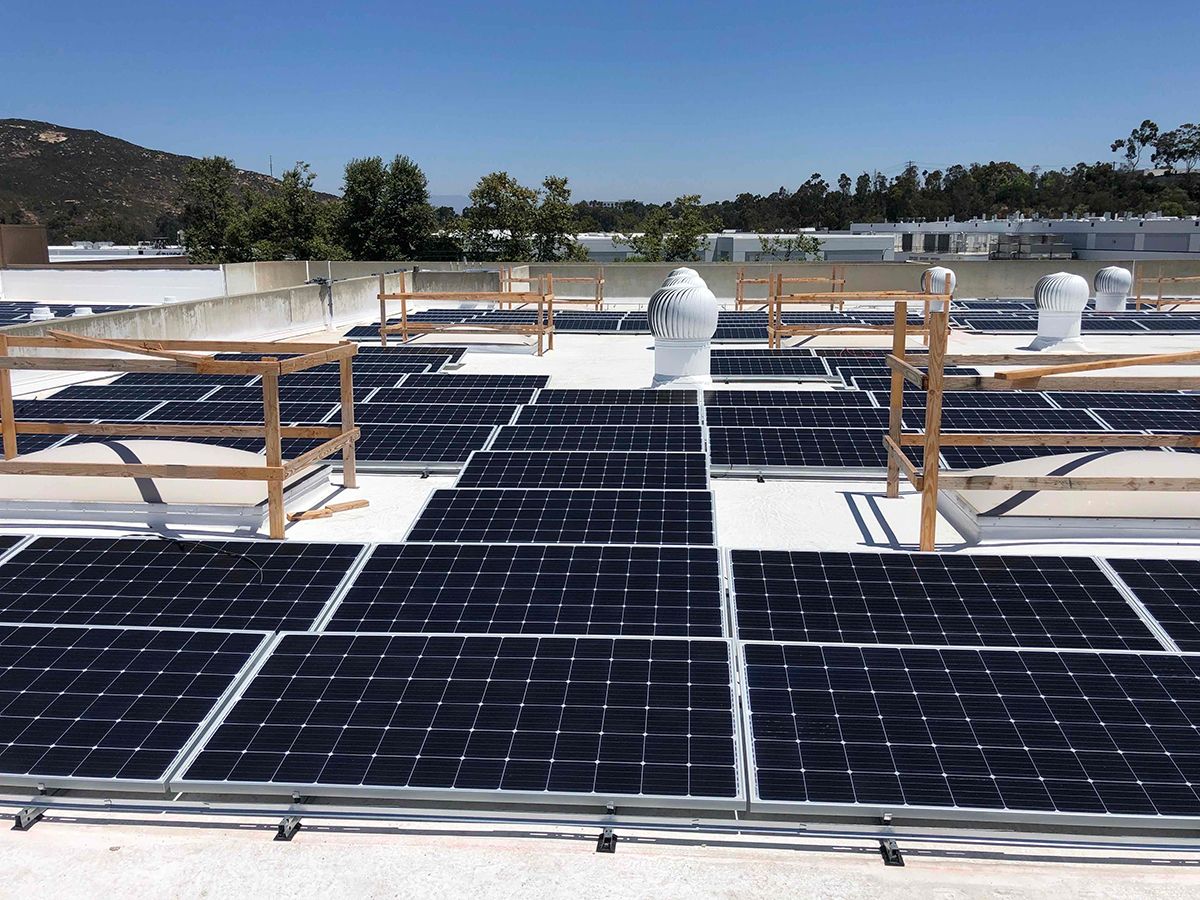

Sign In
Welcome! Sign In to personalize your Cat.com experience
If you already have an existing account with another Cat App, you can use the same account to sign in here
Register Now
One Account. All of Cat.
Your Caterpillar account is the single account you use to log in to select services and applications we offer. Shop for parts and machines online, manage your fleet, go mobile, and more.
Account Information
Site Settings
Security
4000 kVA, 50 Hz Generator Set: Diesel & HVO Test
Abstract
This paper provides details and summary conclusions of the evaluation in a factory test cell of a Cat® C175-20, 4000 kVA, 50 Hz generator set using diesel and hydrotreated vegetable oil (HVO) fuel.
Executive Summary
This paper describes back-to-back tests on a Cat C175-20, 4000 kVA, 50 Hz diesel generator set running on diesel and hydrotreated vegetable oil (HVO) to determine differences in performance, smoke levels and nitrogen oxides (NOx). The findings of the tests, which are detailed in this paper, can be summarized as follows:
Positive Impact Using HVO
- Compared with diesel, smoke emissions were lower.
- Start-up time was faster than diesel, and transient response of HVO was equal or slightly better (lower frequency and voltage droop).
Additional Observations (the following results were expected; they do not preclude the use of HVO as a fuel)
- While running HVO the engine was able to achieve full rated power on the C175-20 generator set, though fueldelivery required was 1.5% higher than with diesel at rated loading.
- NOx emissions were not significantly different at typical loading points (i.e. 0-15% and >50% load).
Introduction
Caterpillar is a world leader in the development and production of heavy-duty diesel engines.
Caterpillar has been monitoring the development of renewable and alternative fuels for decades, and the company is involved in the development of appropriate specifications to ensure the successful application of these fuels in Cat® engines. The most common and currently available liquid renewable fuels are derived from renewable resources such as planted crops (soy, palm, rapeseed, etc.), used cooking oil, animal fat, biomass, algae, and others. According to the GREET model used by California Air Resource Board (CARB), renewable biofuels such as biodiesel and HVO can reduce lifecycle GHG emissions. Your fuel supplier can help you determine which biofuels provide the largest GHG reduction1,2. One form of renewable fuel, hydrotreated vegetable oil (HVO) — also called Renewable Diesel (RD) — is derived from plant and animal fats and oils through a hydrotreating process.
Caterpillar has approved the use of HVO in Cat diesel engines for over a decade. To better understand the performance and environmental impact of using HVO as fuel in a diesel engine, Caterpillar performed a back-to-back study of diesel and HVO fuel in a Cat C175-20 diesel generator set.
Fuels Tested
To provide further guidance on the performance and environmental impact of HVO specific to the C175 SERIES engine, a C175-20 generator set, rated 4000 kVA at 50 Hz was used to perform a back-to-back study of diesel fuel vs. HVO. 100% HVO (R100) was used during this test and was compared to ultra-low sulfur diesel fuel (see Table 1) in a test cell at Caterpillar’s Large Engine Center in Lafayette, Indiana.









1 “California Air Resources Board.” LCFS Pathway Certified Carbon Intensities | California Air Resources Board, 21 Dec. 2018, https://ww2.arb.ca.gov/resources/documents/lcfs-pathway-certified-carbon-intensities.
2 GHG Protocol (www.ghgprotocol.org) currently does not have an established method to determine lifecycle CO2 reductions from the use of biogenic fuels.
Test Set Up
The generator set was evaluated in a test cell at the Caterpillar’s Large Engine Center in Lafayette, Indiana. The test cell is normally used for production testing of generator sets and is equipped with a reactive load bank.
Pictures and diagrams of the test set-up are shown in Figures 1 and 2.
The diesel fuel used for the test was from a common tank that supplies the facility test cells, while a temporary tank for the HVO was installed in an adjacent test cell.
Test Procedure
The procedure for the test which was conducted over a five-day period was as follows:
- Install the generator set and perform test cell debug activities with diesel fuel.
- Perform and record three NFPA (National Fire Protection Association) start-up tests with diesel fuel.
- Perform and record fifteen steady-state performance points with diesel fuel.
- Perform and record two ISO (International Standards Organization) 8528-5 transient load tests with diesel fuel.
- Perform and record two Cat sizing software (SpecSizer) tests with diesel fuel.
- Perform and record four Custom block load tests with diesel fuel.
- Purge the system of diesel fuel by running engine with 100 gallons of HVO.
- Perform and record three NFPA start-up tests with HVO.
- Perform and record fifteen steady-state performance points with HVO.
- Perform and record two ISO 8528-5 transient load tests with HVO.
- Perform and record two SpecSizer tests with HVO.
- Perform and record four Custom block load tests with HVO.
- Purge the system of HVO by running engine with 100 gallons of diesel fuel.
- Change engine and test cell fuel filters.
- Check the package power with diesel fuel, inspect the package, and remove to prepare for shipping.
Start-up tests on both fuel types were first completed with a target jacket water inlet temperature of 40°C. The second and third start-up tests on each fuel type targeted a jacket water inlet temperature of 60°C. The transient tests (ISO 8528-5 and SpecSizer tests) were each run with two voltage regulator settings (2 V/Hz and 4 V/Hz), and one power factor setting (1). The custom block load transient tests were each run with two voltage regulator settings (2 V/Hz and 4 V/Hz), and two power factor settings (0.9 and 1).
At all load points, the engine was operated under two different test methods. First, the engine was operated at equal desired injector fuel delivery as reported by the Engine Control Module (ECM). This test method provides the expected level of power reduction a customer would see at full load when the ECM is limiting the injected fuel quantity. Based on upfront simulation, Caterpillar engineers expected to measure between 0-3% reduction in power with HVO at full load. In the second method, electric power was held constant to measure the difference in fuel consumption at each electrical power output.
Test Results
The test showed the engine achieved 1.1% lower power with HVO at equal injector fuel delivery as reported by the ECM. This is shown in figure 3. The ECM fuel delivery required to achieve equal power with HVO was 1.5% higher, which is within the variability expected from traditional diesel fuel. Because the amount of HVO required for full power was within expected diesel fuel variability, the generator set was able to provide rated power with no adjustments. When operated on HVO fuel, most C175 series generator sets will experience no reduction in rated electrical power output under typical operating conditions.
The fuel consumed was also recorded for these fifteen steady-state points. This is shown in terms of gallons per hour in figure 4. The volumetric fuel consumption is based on a flow meter measurement in the low-pressure fuel system. The fuel consumption increase was equivalent to the difference in energy density per unit volume between HVO and diesel. Customers should plan for slightly higher fuel consumption when running on HVO.
Automotive NOx sensors and smoke opacity measuring equipment were installed to measure emission changes between the different fuels. Relative changes between the fuels should only be considered since these measurements were not taken in a certification test cell. The NOx measurement results show no significant difference at loads above 35% or loads below 15%. The D2 cycle emissions with each fuel were calculated for comparison and no measurable difference was found between HVO and diesel. Steady state smoke was significantly lower with HVO at loads above 30% of rated power. All smoke opacity measurements during the test were considered below what is typically visible. The brake specific NOx and the smoke (using an AVL meter) for fourteen steady-state points are shown in figures 5 and 6.
The generator set was tested transiently to determine the impact of the fuel change. The frequency droop vs. the block load for the SpecSizer test is shown in figure 7. The block load where the frequency droop crosses the G2 limit increases from 0%-59.8% with diesel to 0%-62.2% with HVO.
Figure 8 shows pictorially the frequency behavior with diesel vs HVO during the SpecSizer test at block loads of interest. This figure shows both the frequency droop and the frequency recovery of both fuels.
Start-up testing with cold and warm engine coolant temperatures found that HVO performed similarly to diesel. HVO was able to achieve start up and ramp to rated power a fraction of a second faster than diesel for both cold and warm temperatures.
Caterpillar has also evaluated the compatibility of elastomers used in the C175 Series fuel system with HVO through aging testing. Cat® seals and hose materials are compatible with HVO and all HVO-diesel blends, with no negative impacts to the components.
Other C175 Series ratings are expected to have the same directional impact as was measured in this test data when converting from diesel to HVO. It is recommended that the end user consult the fuel supplier for information regarding the safe handling and storage of HVO.
Summary
The tests demonstrated the viability of HVO as an alternative to diesel fuel:
- While running HVO, the C175-20 generator set engine was able to achieve full rated power.
- Fuel consumption was slightly higher using HVO at all points measured.
- Overall, lower smoke soot emissions were recorded when using HVO. For the smoke opacity test, the resultsusing HVO were approximately 50% of diesel at loads above 30% of the rating.
- On average, transient response tests showed 1.3% less frequency droop with HVO.
- Start-up time using HVO was equal or slightly faster than diesel.
Other C175 Series generator set ratings are expected to have the same directional impact as was measured in this test data when converting from diesel to HVO.
